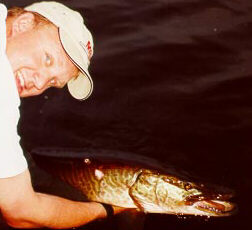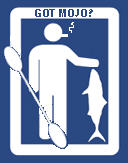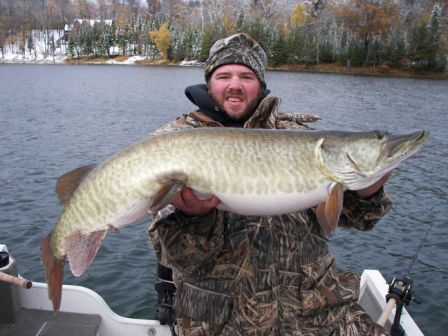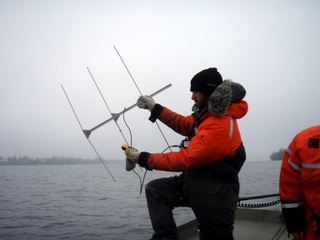|
|

Posts: 714
Location: Rhinelander, WI | I have some quick questions regarding when muskies spawn. Have there been any studies done to actually determine what triggers spawning. Everyone usually says between 50 and 55 degrees, but on pelican lake this weekend we spotted what appeared to be a mated pare of muskies, they weren’t together at the time but where 10 feet apart on a feeding structure. One mid 30 inches and one mid 40 inches both beat up and looked like they already went through the spawning process. We spotted them at night with a spot light on a rocky break line. A great early season walleye spot, when muskies aren’t hanging out there feeding.
Any way these fish appeared to have already spawned and the water temp was 42 degrees. Could photo periodism have more to do with it than many think?
Thanks
Nail A Pig!
Mike | |
| | |
Posts: 720
| Good Morning Mike,
I'm just an angler with no science background at all and this is an ongoing discussion with me and my friends. I think that musky are just like deer. Timing of the spawn is related to a lot of things. Sun light angle, day length, water temps and water clarity. All these things play a role in the activation of procreation. I do think the issue of daylight is what drives the spawn and things like water temps and clarity effect the intensity of the spawn.
Much like deer in Wisconsin the rut always hits that first week of November often peaking around between the 7th thru the 10th. Does not matter wheather its 8 degrees or 80 degrees the rut always comes around the same time every year. I don't think its too different for musky. Again Mike these are just my thoughts and please feel free to correct me on any level of this topic. These are just my thoughts on the subject.
My question to you Mike, is this. Does a late spring like this one with late ice out and cold water temps during the spawn effect the quality of this years brooding stock? Are the numbers of the fish produced effected?
Dave
Edited by Hunter4 5/5/2008 8:09 AM
| |
| | |

Posts: 1764
Location: Ogden, Ut | Personally, I think photoperiodism has a lot to do with it Mike. Being cold-blooded, the maturation of gametes can be delayed substantially by water temperature, but much of that development is already accomplished prior to 'the spawn'. They can only 'cross their fins' so long before the gametes must be expelled or they begin to be reabsorbed by the body.
Now I'm not sure what effect that has on the success of fertilization or the subsequent development of the embryos (probably retards that process a bit too), but I'm pretty sure that the spawn can go on in colder than normal waters. Mother Nature has also insured that a bit also by providing the species with a wide genetic suite of 'preferred' spawning temperatures. That is why it is usually reported as a range - and that range is only where a majority of the individuals spawn, there are outliers on both ends to insure some success regardless of the conditions in the spring.
Shooting for a temperature has also been a fantastic surrogate for photoperiod also - since it usually happens at about the same time each year. Temperature is a bit more reliable, but spawning times can be manipulated by artificially varying either. For example, the rainbows in our hatchery system have been 'altered' so that we have different lots that now can be spawned successfully 10 months of the year. This was done primarily by varying photoperiod (since our water source was constant and not readily changed). Now muskies are not rainbows, so I'm not positive how closely they are tied to temps.
S. | |
| | |
Posts: 178
| Mike, I have time for one quick reply to your timely topic.
Most fishery biologists believe that photoperiod and egg maturation time (the number of days required for eggs to become fully developed overwinter) are the main factors governing when fish spawn. Temperature can modify spawning time somewhat, but day length seems to matter more. If it's a late spring, like this year, eggs have had plenty of time to develop, and day length tells the fish it's TIME, regardless of sub-optimal temperature. For example, we've seen a couple spawned-out female muskies this year that were captured when water temperature was only in the mid to upper 40s (optimal temperatures thought to be 50-55 F). In addition to temperature, stream flow can influence the timing of spawning runs for fish that spawn in rivers.
It has been demonstrated in many fish species that genetics plays a major role in determining when individual fish are compelled to spawn. In fact, "run timing" is one of the most obviously genetically influenced traits in fish. In a changing climate, it is in the best interest of long-term survival for a species to be fairly flexible in this regard. In naturally reproducing populations, we want individual fish to possess a wide range of "urges" regarding WHEN they spawn. Spreading out the timing of the spawn increases the odds that SOMEBODY'S eggs are going to hatch successfully and survive, despite variations in water temperature, water level, and prey availability for the young hatchlings.
This is why it's important for us to try to follow Dr. Sloss' suggestions for obtaining hatchery broodstock over as wide a range of dates as possible -- to conserve genetic diversity with respect to run timing. In the past, we would simply capture as many fish as possible as soon as they were ready, then fertilze the eggs until enough were secured for production. There are SERIOUS logistical challenges associated with changing that method and deliberately extending the time during which eggs are taken and fertilized, but we will be working on that in the years to come.
Dave Neuswanger
Fisheries Team Leader, Upper Chippewa Basin
Wisconsin DNR, Hayward | |
| | |

Posts: 299
Location: Nowheresville, MN | Very good points Sorno. But, I'm still sticking to temperature. I think fertilization rates are the key variable here. Fish may spawn or be spawned by man based upon photoperiod, but the fertilization rates can be very low. As said, the eggs are matured already, almost. They need 7-10 days to finalize maturation when it's go time. These weird springs are what confuses things. The temperature to initiate the final stage of maturation may be hit, but then a cold front may come and the "ideal" temps may not be reached when the eggs are ready.
I still like to use this simple analogy. Southern MN and Mille Lacs. I'm guessing the difference in day length is mute. In fact the increase in daily daylight should be the same. Fish have commenced/finished spawning in southern MN. There is still ice on ML. These fish come from the same parents. | |
| | |

Posts: 16632
Location: The desert | Interesting topic. I can see both sides of it. My question would be why in some years do some fish absorb their eggs instead of spawning out. Wouldn't the photoperiod be similar year in and year out so in theory they should spawn out every year? Or maybe I'm just not thinking right this morning after 3 hours of sleep? | |
| | |
Posts: 1299
Location: Hayward, Wisconsin | According to the observations of Art Oehmcke, the father of Wisconsin Muskellunge propagation, water temperature and weather conditions played a huge part in muskellunge spawning...or not. He found that at times severe weather conditions (i.e., cold fronts and related water temperature decline) would push the muskies out of the spawning grounds. Sometimes they came back and finished and sometimes they didn't, which could lead to absorption of that years eggs. So photo-period notwithstanding, water temperature apparently does or can play a significent part in the process. | |
| | |

Posts: 691
Location: nationwide | Possibly a stupid question here but in the case of fish re-absorbing their egg mass does this mean the fish are less prone to "normal" feeding meaning they are less apt to be caught and cause a "bad year" for fishing on a given body of water.
Also do the males go through the same process with their "milt mass" I guess you would call it?
I am not much of a biologist . . .and I have not stayed at a Holiday Inn Express in quite awhile.
Corey Meyer | |
| | |
Posts: 178
| COREY MEYER asked: "...in the case of fish re-absorbing their egg mass does this mean the fish are less prone to "normal" feeding meaning they are less apt to be caught and cause a "bad year" for fishing on a given body of water? Also do the males go through the same process with their "milt mass" I guess you would call it?"
DAVE: Corey, though female fish sometimes resorb their eggs when spawning conditions are unfavorable, there is not enough energy in those eggs (which are mostly water) to sustain a fish for very long. I'm not sure egg resorption affects feeding activity at all; but if it does, the effect would be very short-lived and would not influence your fishing success once the season opens in Wisconsin. This is even more true of male muskellunge, which have notoriously little milt in their testes. It's actually a problem for the hatchery crews, sometimes, to obtain enough milt from any one male to adequately fertilize a quart of eggs from a female. Yet another reason to use up to 3 males, if possible, to fertilize the eggs from any one female.
Larry Ramsell brought up a good point too, recounting Art Oehmke's observations on the dampening effect of a big cold front on muskie spawning behavior. That same phenomenon is observed in bass, crappie, and possibly other species. And as Art/Larry have said and I have observed personally, repeated or prolonged cold fronts can cause some fish (including muskellunge) to simply give up on spawning for the year and resorb their eggs.
Of particular interest in muskellunge, however, is the existence of a bimodal distribution in the diameter of eggs in the ovaries of large, mature females. In other words, often there are "two batches" of eggs of different diameters, suggesting that any given large female is prepared to spawn more than once in a season. A big girl will spawn when photoperiod and temperature are right; but we speculate that if water temperature or other conditions deteriorate during the egg incubation period, the SECOND batch of eggs may mature and be released once conditions improve again -- the eggs that were too small (and not loose enough) to be released on the first spawning attempt. I'm not sure what happens if all goes well on the first attempt, but I suspect the second batch of eggs gets resorbed in many if not most cases. It's still a bit of a mystery, but it's easy to see how the production of two batches of eggs would be a good adaptation to ensure reproduction and survival of the species. If at first you don't succeed...
Dave Neuswanger
Fisheries Team Leader, Upper Chippewa Basin
Wisconsin DNR, Hayward | |
| | |
Location: Green Bay, WI | Excellent point about the fractional spawning Dave...also alluded to by Larry.
In Larry's In-Fisherman article about his work with Dr. LeBeau several years ago, he talks about fractional spawning. I found this very interesting, and am in the process of ordering a copy of Dr. LeBeau's PhD thesis through a company in Michigan. Work has been busy the last two days, but I need to get this done today.
Every time I read that In-Fisherman article it fascinates me more & more. How amazing is it that Larry Ramsell, as then-VP of Research for MI, just drops everything and goes to Canada to spend the summer helping with that field work! That's a pretty hefty standard for us future VPs to uphold, lol...
(Dave, do you need an extra pair of hands for a few months?)
TB | |
| | |
Posts: 1299
Location: Hayward, Wisconsin | According to B. Lebeau and G. Pageau (1986):
(Definitions: Riverine muskellunge; sympatric or co-existing historically with pike in the northern part of the range. Lacustrine muskellunge; allopatric or living historically in water absent of pike [not referenced here].)
..."In esocids, unlike some other fishes, there is maximum ovarian volume. Therefore, the larger number of eggs produced by the (riverine-Lebeau 1986, pers. comm.) muskellunge, in contrast to that of northern pike, cannot all reach maximum size simultaneously. By some adaptive mechanism in (riverine)muskellunge virtually all egg development is halted at the end of stage V until a few days before spawning. At stage VI (start of spawning) the larger oocytes of the more advanced mode become free from the follicle and are at stage VII when deposited. Following this, the eggs in the less-advanced mode complete vitellogenesis and are deposited several days later.
This bimodal development pattern of oocytes is considered to be an adaptation, which allows an individual to carry and deposit a larger number of eggs than would otherwise be possible with the morphological limitations of the ovary. This confers in the (riverine) muskellunge the status of a multiple spawner..."
(note: Lebeau found lacustrine musekellunge to be single spawners with far less numbers of smaller eggs.)
From Lebeau (1992; page 227):
"(Riverine) Muskellunge is a fractional spawner, laying eggs in two successive clutches two weeks apart (Lebeau 1991). Agitation and mixing of the substrate by adults spawning a second time, likely cause eggs and eleutheroembryos from the first clutch to settle deeper into the soft bottom, thus increasing their mortality by suffocation. Data on pike eggs artificially fertilized late in the spawning season and deposited onto the same substrate as those fertilized earlier, had higher survival (75 vs 15% in Forney 1968), indicating that the second clutch of eggs in (riverine)muskellunge may also be more successful. Oocyte counts in large female (riverine) muskellunge reveal that the second clutch of eggs is equally important to the first (Lebeau 1991), demonstrating that the second spawning episode may be responsible for a significant proportion of (riverine) muskellunge recruitment. This aspect remains beyond the scope of the present study."
As an aside here, I believe this would be an additional reason for the protection of muskellunge during the spawning season.
Muskie regards,
Larry Ramsell
www.larryramsell.com
| |
| | |

Location: Grand Rapids, MI | tfootstalker - 5/6/2008 6:25 PM
I still like to use this simple analogy. Southern MN and Mille Lacs. I'm guessing the difference in day length is mute. In fact the increase in daily daylight should be the same. Fish have commenced/finished spawning in southern MN. There is still ice on ML. These fish come from the same parents.
I know you used this example earlier on the Gen. forum and I didn't reply when I listed the factors, which happen to be the same as the biologists above. With all things being equal the length of daylight is actually longer in the north. However, the ice cover would confuse the fish. Ice has a high light refraction index and therefore it will appear light later and dark earlier under water w/ice.
Perhaps the biologists can confirm this but hatch time and not fertilization will be affected by water temp.
Edited by Will Schultz 5/8/2008 11:04 AM
| |
| | |

Posts: 299
Location: Nowheresville, MN | If the eggs are released too early in their maturation stage, they will not readily accept sperm. So in my opinion, water temperature can also affect fertilization rates. Same goes for man stripping females. Strip them a day or several before they would be naturally released and the fertilization rates suffer.
Something also to consider along the lines that Dave mentioned. The cooler water temps may affect the sperm motility more than egg receptiveness. You have very little sperm to begin with, if they have trouble swimming you have a double whammy.
Having just stripped over 1,000,000 eggs, monitoring water temperatures, and watching fertilization rates come in... I'm still rolling with water temperature.
Edited by tfootstalker 5/8/2008 1:57 PM
| |
| | |

Posts: 999
| Doug Johnson wrote a piece in an Esox Angler article a few years back on how musky's spawn twice. If Doug is on maybe he can elaborate.
Mr Musky | |
| | |

Posts: 906
Location: Warroad, Mn | Lots of good points made here, Sort of shows that muskies do lots of different things.
I'm sort of lucky in that I have a muskie spawning bay right behind my cabin on the LOTWs and can sit on the dock and watch. Pretty cool stuff! Sometimes I'll see the same female for two or three days with what looks to be different males. Often I'll see circling fish, "the same fish will swim past my dock like clockwork for several hours", then appear to get lucky and go by paired up the next time.
Ive seen spawning activity on the LOTWs from water temps from the high 40's to the mid-60's (late May till mid-June). It quite common to see spawning fish during the first week of muskie season, and usually water temps are quite high. I suspect that these last spawners are very successful as the eggs would mature very fast, and weed growth is well established, giving the young of the year a great nursery. This would sort of tell me that at least some of the fish are spawning twice. Perhaps not all, but some of them. However, I'll bet that if spawning conditions are very good they will continues on as long as egg maturation allows. At the same time under extreme cold front conditions I've seem my bay clear out over night.
I also fish a southern lake that has an increasing muskie population. This lake also has a large steam plant that has a warm water discharge. Wintertime water temperatures in this area and for several miles down the lake are quite often on the mid to high 60's and yet there is no indication of spawning activity during the months of February, March and early April. So water temperatures aren't the trigger in this environment. This area has a high winter time population of muskies.
Biologists tell me that muskies in this area spawn near the end of April, so egg maturation or phototropism would be the trigger in this enviroment, or perhaps thie muskie strain (Ohio) in the lake. Interestingly they have recently stocked some Great Lakes strain fish in this lake, it'll be interesting to see what they do.
I suspect that what triggers the spawn is a combination of many things, egg maturation could well be the most important thing. No doubt phototropism, and water temperature play a roll, but it's different from area to area and probably with different stains of fish. The Ohio strain would face much different conditions during the spring than the Great Lakes strain and react differently to these conditions.
Doug Johnson
| |
| | |

Posts: 906
Location: Warroad, Mn | I was in Whitefish Bay starting Sunday afternoon, and noticed that water temps was 50.1 when I pulled up to the dock. Within five minutes I had a 42"-43" fish come cruising by. He looked like he had all ready had some action as I could see that he (or possibly she) was already had some missing scales and looked a little scared up. In the next couple of days I must have seen 7-8 different fish doing the circle in the bay, but none actually spawning. Water temps started out at 50 degrees and went to around 55 or so. The same fish would often appear sometimes going left and sometimes going right, sure looks like they are looking for a mate. Biggest fish at around 48"s or so but most over 40".
Sort of like a big singles bar! Pretty interesting.
Doug Johnson | |
| | |
Posts: 3518
Location: north central wisconsin | Interesting stuff. I used to think Muskies were long done spawning before the 'preferred' temps, as watching them spawn on the WI River and other southern waters over the years in water lower than 50 degrees emphasized the belief. However, each year for the past 8 years, I've been watching Muskies on Green Bay, spawn with water temps into the mid to high 60's. I see this each year out there. I would think that this would be their second 'drop', but last weekend on the Green Bay/Fox River opener emphasized the opposite, again, when I released a big, clean, obviously pre-spawn fish. We've also caught fish into June, still dumping eggs when caught, even with temps in the bay at well over 60. I know that photo period induced spawning would have long occured. Could these first round spawning fish be coming from great depths of cool water, only to find the shallows quite warm already? Can they be successful in this 65+ degree water?
Edited by Reef Hawg 6/1/2008 10:38 AM
| |
| | |

Posts: 2024
| Very impressed by the genuine interest that many on this board show for this species. It's quite evident many don't just "fish" them, but "study" them as well!
I think another interesting question is whether there is a significant correlation between female AND male size and hatching success. For instance, if you have a 50" female spawning with a 30" male versus a 50" female spawning with a 43" male, do the eggs from the second pair have a greater chance of surviving? There have been several studies on this question with bass, and it appears there is a correlation between male size and offspring survival. Also, do bigger females spawn earlier? Are these eggs more likely to survive? It's been hypothesized that, for bass, eggs that are produced and fertilized sooner (in cooler water) may contribute disproportionately to that year class as these individuals develop faster, grow bigger sooner, and can thus reach a larger size by winter when resources are at their most limited.
Ok, so I've talked a bunch about bass here, but I guess the point is the questions we raise about muskie spawning is pretty similar to what has been raised for bass. However, muskies are not a well studied species. One would think you could fyke/trap net females and males, fertilize eggs in vitro, and test at what temperatures hatching success is greatest and possibly fry mortality is greatest (though rearing fry may be a bit more difficult). You could test for statistical significance for parameters like strain, size (male and female), substrate eggs were laid on, depth eggs were laid at, etc.
Good stuff guys! | |
| | |
Location: Green Bay, WI | Good questions Sean--and another question is whether or not larger females tend to spawn fractionally, when compared to smaller females. Common sense would suggest that, given the sheer increase in egg volume in a larger female, it would take longer for her to spawn. I realize that not all larger females have devoted all of their energy into gonadal growth, but I would guess that the average female would have--so the potential for fractional spawning seems more logical for a larger fish.
I received Dr. Lebeau's Doctoral thesis last week, but haven't read it yet. But I thought Larry Ramsell mentioned something about there being some fractional spawning data in there. I plan to start going through it within the next week or so...
TB | |
| | |
| can sombody please explain what phototropisim is
sorry for the dumb question | |
| | |
Location: Green Bay, WI | "Photo" = light
"tropism" = growth in response to some stimulus
So basically, phototropism is growth in response to light stimulus--such as changing periods of light intensity or duration.
http://en.wikipedia.org/wiki/Phototropism
TB | |
| | |

Posts: 2754
Location: Mauston, Wisconsin | Sean- I don't think the size of the male makes any difference with muskies, i.e., your comparison to bass. With bass, the male guards the nest. So it would make sense that the larger male's are more successful at protecting the YOY. Just a thought.
Al | |
| | |
| It's possible, Al, but my question is not so much behavioral. You're right, larger bass are more aggressive and tenacious when protecting their broods hence the (typically) higher survival rates of offspring from larger males, but it is also possible that their gametes are of a higher "quality." So how do we define this this quality? How does it relate to size, if at all? Is a large male muskies sperm more motile, leading to increased fertilization? Do they (large males) tend to (here's a behavioral question) spawn earlier than smaller males? I would think that larger, more developed YOY are better able to survive the winter which leads to increased recruitment rates. I've only witnessed spawning once, so I cannot speak from experience re: this last question. Anyway, these are the types of questions that COULD be explored. | |
| | |
Location: Green Bay, WI | I think like in humans, the quality of sexual gametes is thought to diminish with age. Here's one example that (for humans anyway), puts a value on the decline:
http://humrep.oxfordjournals.org/cgi/content/abstract/18/2/447
Note that sperm motility decreases by 3.1% per year of age, and quantity of *motile* sperm decreased by 4.7% for men between the ages of 22 and 80...at least in that study.
While muskies are not human obviously (some are smarter than some humans I've met...), I think it is widely accepted that reproductive success and quality of gametes declines with increasing age of the animal(s). This is basic science 101, and is one argument that has been used *against* the 54" size limit increase in Green Bay--the 50+" fish just aren't that important to the total "quality" of any particular year's spawn. And while the whole value of "big fish genes" is a pretty hot topic right now, I am not sure you'd find too many biologists to agree with the notion that eggs (or sperm) from the largest fish in the population are that vital to the overall success of the spawn. At least none that I know have gone as far as to say that.
About the only (somewhat) contradictory opinion I've seen offered to this was just recently, in the Musky/Pike edition of In-Fisherman's magazine. Gord Pyzer wrote a nice article and mentioned that large female muskies (I took it to mean the largest animals in the population) produced lots & lots of eggs, implying that this would enhance reproductive success. I am not sure what his references were to support this, but he's an accomplished biologist--so I am pretty comfortable that there must be something behind the idea. I have not spoken to him about this though, and would love the opportunity to do so.
TB | |
| | |

Posts: 906
Location: Warroad, Mn | The shear volume of eggs and sperm produced by large specimens of fish probably over rides any decrease in egg or sperm vitality caused by old age. Most warm blooded creatures produce few eggs. Fish, particularly large ones produce many. I don't know of any study that shows that there's lower egg or sperm vitality in cold blooded animals as they age all though they may well.
I feel the biggest reason to protect the largest fish for spawning purposes is that they have proven large fish genetics, just because they are large. They also lay lots of eggs! I would think that Gord Pyzors ideas are something along this line and probably essential in lakes that rely on natural reproduction.
Doug Johnson
Edited by dougj 6/13/2008 5:30 PM
| |
| | |
Location: Green Bay, WI | Thanks for the reply Doug. I spoke with Gord for 90 minutes yesterday, and he basically agrees (to summarize) with what you just said. He also had some very insightful comments about the Green Bay situation, which I found most interesting.
It's easy to tell his immense fund of knowledge regarding sport fisheries, and muskellunge & walleye fisheries in particular. It was an honor and a great pleasure to talk to the man.
TB | |
| | |

Posts: 2024
| I agree whole-heartedly with Doug; it is essential to protect the largest fish in a system (particularly sport fisheries, but possibly commercial fisheries too). Whether the justification is "big fish genes" or enhanced reproductive success (increased recruitment) through increased fecundity.
Since muskies do not exhibit parental care or vivipary (give birth to live young) and are classified as "broadcast spawners" they must overcome this lack of "quality" in their young by producing massive amounts of eggs and sperm to increase the probability of successful fertilization. It is widely accepted that their is an exponential relationship between size and gamete production (particularly eggs) in most fish species. One GLARING example is ONE 61cm red snapper can produce as many eggs as 212 42cm fish (Bohnsack 1990). Again, these fish are BROADCAST spawners and MUST overcome lowered reproductive success by increasing gamete production.
I find it somewhat odd that biologists would not agree that the largest fish in a population are "vital to the overall success of the spawn," if not based solely on the fact that they may very likely produce a disproportionate amount of gametes and thus, very likely, offspring to the population. As a disclaimer, I understand that this MAY NOT be the be-all end-all, but it is something that is difficult to refute. Maybe Mr. Neuswanger can shed some light on this line of thought?
[Bohnsack, J.A. (1990) The potetntial of marine fishery reserves for reef fish management in the U.S. Southern Atlantic. NOAA Technical Memorandum NMFS-SEFC (261): 1-45.]
Edited by esox50 6/13/2008 9:15 AM
| |
| |
|
 Musky Spawing ?s
Musky Spawing ?s Musky Spawing ?s
Musky Spawing ?s